Papers by Dmitri Mikulski

Murudj al-dhahab… (“The Meadows of Gold …”) by al-Mas‘udi: entertaining narrations on the caliphs of the Umayyad dynasty, their courtiers, their adversaries and ordinary people, who lived under the rule of these sovereigns, 2024
The great Arab-Muslim historian, geographer and traveler al-Mas‘udi
(d. 956) was also a remarkabl... more The great Arab-Muslim historian, geographer and traveler al-Mas‘udi
(d. 956) was also a remarkable story-teller. This reputation of the Author is rightly
based upon the main of the two remaining his works, that is Murudj al-dhahab wa
ma‘adin al-djawhar (“The Meadows of Gold and the Mines of Gems”). In the section of
this work, where the events of the rule of the Umayyad dynasty (661–750) are related,
al-Mas‘udi creates vivid images of the caliphs, of their adversaries, their courtiers,
as well as of ordinary people, who lived in the epoch of their reign. It is testiied by the
academic translation of a number of novellas (stories) and passages of other genres
manifested in the present publication. These translations are interesting to both experts
in Oriental studies and to a broad reading circle.
The beginning of the period of “The Second Direct Turkish rule” in Lybia in the work of Ahmad-Bek al-Ansari (during the rein of the Sultan Mahmud the Second (1808 – 1839) , 2023
The chronicle "al-Manhal al-azb fi ta'rikh Tarabulus al-Gharb" (late 19 century) is one of the ma... more The chronicle "al-Manhal al-azb fi ta'rikh Tarabulus al-Gharb" (late 19 century) is one of the main sources on the history of Premodern Lybia. In the paper is presented the information on the establishment of the direct Osmani rule over the region in 1835.
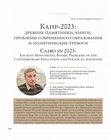
Cairo 2023: ancient monuments, books, problems of the contemporary education and political anxieties, 2024
One of the favorite Arab cities for D.V. Mikulski is the great and inexhaustible Cairo. Visiting... more One of the favorite Arab cities for D.V. Mikulski is the great and inexhaustible Cairo. Visiting it in November 2023 the Autor of the present article managed to through a glance on the antiquities and the contemporary life of the capital of the Nile Country through the eyes of the professional Egyptian guide Mr. Ashraf, a descendant of the Mamluk warriors (they were ruling Egypt in the 13 – 16 centuries) and the Bedouins, who reside at the foots of the Great Pyramids since the 10-the century. Mr. Ashraf was relating the history of his family, showed the Pyramids and the Sphynx, a part of the treasures of the Egyptian Museum, the Coptic Church of St. Sergius and Bacchus (Abu Sarga) and the famous market of Khan al-Khalili. The Russian Arabist was listening, and making mental notes of what was said, and keeping an eye on everything. Besides he visited book stalls, where purchased a rear book, and observed what was happening at the evening streets of Cairo. Meanwhile the delegation, with which the Author of the article was visiting Egypt, met with the Russian Ambassador, took part in the opening ceremony of “The Russian Education in Egypt” exhibition, carried out the academic and practical conference “A Human Being and the Values of the Contemporary World”, where the Author of the present lines had the honor of carrying out Arabic-Russian simultaneous interpretation. So in Cairo of the present day there occured an encounter of the Ancient Epoch, the Middle Ages, the traditional Egyptian life-style and the most acute contemporaneity. That is what has narrated D.V. Mikulsky about.
The Leningrad (dating to the Siege) edition of “The Song of Roland” (1943), 2023
The Leningrad (dating to the Siege) edition of “The Song of Roland” (1943)
... more The Leningrad (dating to the Siege) edition of “The Song of Roland” (1943)
Summary
A.A. Dolinina is the contemporary of the Second World War at the territory of the former Soviet Union and of the Siege of the City on the Banks of Neva River. We gained the Victory owing to the firmness of our soldiers as well as thanks to the devout serving, on whom it was bestowed to preserve and to present to the Nation the great Universal and National cultural values.
A testimony of that is the edition of a free translation of “The Song of Roland”, carried out in 1943, soon after the break of the Siege. It is a worthy landmark of that Great Epoch.
About the Arabian Poet and Hanif Umaiya ibn Abī s-Salt in al Masoudi’s Work Meadows of Gold and the Mines of Germs (d. 956), 2023
Umayya b. Abu 'l-Salt is one of the remarkable personalities of the Arabic historical tradition a... more Umayya b. Abu 'l-Salt is one of the remarkable personalities of the Arabic historical tradition about Pre-Islamic Arabia. Extremely peculiar are the materials, that are dedicated to him in the “Meadows of Gold and the Mines of Germs” by the great Arabic historian, geographer and man of letters al-Mas‘udi (d. 956). The said work is the main book by the mentioned Author. In organizing these materials al-Mas‘udi displays a high degree of literary skill and artistic taste.
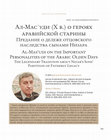
Al-Mas‘udi on the Important Personalities of the Arabic Olden Days The Legendary Tradition about Nizar’s Sons’ Partition of Fatherly Legacy, 2023
Among the materials of Murudj al-Dhahab wa Ma‘adin al-Djawhar (“The Meadows of Gold and the Mines... more Among the materials of Murudj al-Dhahab wa Ma‘adin al-Djawhar (“The Meadows of Gold and the Mines of Gems”) by al-Mas‘udi (10th century), dedicated to pre-Islamic Arabia, one notes the legendary tradition about the sons of Nizar, the for-father of the so called Northern Arabs: Unable to comprehend their father’s testimony, they turned for help to the wise king al-Af‘a b. al-Af‘a al-Djurhumi. On their way to the sage and during their stay at his lodging Nizar’s sons manifested unusual power for insight,earned the host’s favour and managed with the king’s help to understand their father’s will. It appeared that the testimony later influenced Nizar’s sons’ descendants’ way of life, as well as that of the members of major Arab tribes and tribe unions. The author displays the folklore origin of the story under study and also shows that, from the viewpoint of al-Mas‘udi, Nizar’s sons proved to be the masters of kiyafa, the specific Bedouin art of divination. Some tribes and clans of their descendants were later renowned for practicing that sort of skill. In addition to the study the author presents an academic translation of al-Mas‘udi’s version of the legendary tradition under question, as it is framed by an important cultural and historical context. Besides, the legend as presented by al-Mas‘udi possesses uncontestable literary qualities. For the sake of comparison, the academic translation of the version, presented by al-Tabari (839–923), is also delivered.
Keywords: al-Mas‘udi, Arab-Muslim science of History, Medieval literature and folklore, kiyafa, traditions about the origin of the Arabs, Bedouins in the pre-Islamic epoch, pre-Islamic Arabia inArab-Muslim history writing
For citation: Mikulsky Dimitry V. Al-Mas‘udi on the Important Personalities of the Arabic Olden
Days. The Legendary Tradition about the Nizar’s Sons’ Partition of Fatherly Legacy. Oriental Courier.
2023. No. 1. Pp. 251–263. DOI: 10.18254/S268684310025328-8
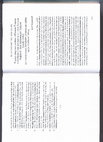
The First World War in South Yemen as depicted by the historian and poet Ahmad Fadl b. ‘Ali Muhsin al-‘Abdali (1881 – 1943) (on the basis of Hadiyyat al-zaman fi akhbar muluk Lahdj wa ‘Adan), 2022
Ahmad Fadl ‘Ali al-‘Abdali (1881 – 1943) is a remarkable person in the South-Yemeni culture of th... more Ahmad Fadl ‘Ali al-‘Abdali (1881 – 1943) is a remarkable person in the South-Yemeni culture of the end of the 19 century -- the first halve of the 20 century. One of the spheres of activities, where he acquired fame, was History-writing. The evidence to that is his work Hadiyyat al-zaman fi akhbar muluk Lahdj wa ‘Adan (“The Gift of the Times concerning the Pieces of Intelligence on the Kings of Lahdj and Aden”), which was published in the Year 1351 (1932-33) of the Hidjra. In the framework of this book Ahmad Fadl al-‘Abdali dedicated chapters 16 – 18 to the developments of World War I in the territory of Southern Yemen, and specifically in his native Lahdj Sultanate. The volume of the text, contained by these chapters, comprises over 26% of the overall text-volume of the work under study. While narrating the story of the war vicissitudes the South-Yemeni man of letters follows the traditional style, characteristic of the Arabic works of history. The text of his book is comprised by textual units belonging to narrative genres (brief pieces of information, literary historic narrations and anecdotes), “alien” texts (letters, poetical pieces and an exposition of a single newspaper article), editorial “markers” (Author’s remarks, exposition of the content of the chapters, chapters headings). Basically the segments that comprise the textual structure of the part of the work under study bear traditional character, with the exception of the brief expositions of the contents of the chapters. Besides the exposition of the newspaper article should be considers as an undisputable element of modernization. The study, presented in the article, shows that al-‘Abdali’s narration on the events of World War I in South Yemen is a vivid evidence, made by an eye-witness, a person of traditional learning who was working in the 20-th century..

Oriental Courier
Cleopatra (69–30 B. C.) is the last of the sovereigns (51–30 B. C.) of the Ptolemaic Dynasty, tha... more Cleopatra (69–30 B. C.) is the last of the sovereigns (51–30 B. C.) of the Ptolemaic Dynasty, that was ruling Egypt in the 4th–1st centuries B. C. As early as in the writings of the authors of Antiquity, she acquired fame as an irresistible and voluptuous beauty. But most of all she became famous for having courageously put an end to her life through a bite of a poisonous snake, as she hated to fall prey to the first Roman Emperor Octavian August (63 B. C. – 14 A. D.; since 31 B. C. — the individual ruler of the Roman State). The fate of the Egyptian Queen was inspiring many European creators of culture in different eras: at the dawn of Modern Times, during the epoch of Romanticism and in the 20th century. The great Arab-Muslim traveler, geographer, historian and belletrist al-Mas‘udi (d. 956) was informed about Cleopatra. He installed into his main surviving work “The Meadows of Gold and the Mines of Germs” the story of the death of the Royal Beauty, which bears a most tragic chara...
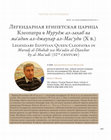
Cleopatra (69 – 30 B.C.) is the last of the sovereigns (51 – 30 B.C.) of the Ptolemaic Dynasty, t... more Cleopatra (69 – 30 B.C.) is the last of the sovereigns (51 – 30 B.C.) of the Ptolemaic Dynasty, that was ruling Egypt in the 4-th – 1-st centuries B.C. As early as in the writings of the authors of Antiquity she acquired fame as an irresistible and voluptuous beauty. But most of all she became famous for having courageously put an end to her life through a bite of a poisonous snake, as she hated to fall prey to the first Roman Emperor Octavian August (63 B.C. – 14 A.D.; since 31 B.C. – the individual ruler of the Roman State). The fate of the Egyptian Queen was inspiring many European creators of culture in different eras: at the dawn of Modern Times, during the epoch of Romanticism and in the 20-th century. The great Arab-Muslim traveler, geographer, historian and belletrist al-Mas‘udi (d. 956) was informed about Cleopatra. He installed into his main surviving work “The Meadows of Gold and the Mines of Germs” the story of the death of the Royal Beauty, which bears a most tragic character. In the version of al-Mas‘udi justice is triumphant, as cruel August (Ughustus) suffers due punishment. While publishing the academic translation of the story about the death of the Egyptian Queen the author of the present lines hopes that it would be interesting both for the academic experts and for the general reader. As a supplement the translation of the life of Ughustus (Octavian August) is attached, which is made on the basis of the same source.
SELECTED NOVELLAS FROM AL-BASA’IR WA-L-DHAKHA’IR BY ABU HAYYAN AL-TAWHIDI (AN ACADEMIC TRANSLATION WITH A COMMENTARY), 2022
Abu Hayyan al-Tawhidi (born between 922 and 933; dead circa 1023) is considered as one of the mos... more Abu Hayyan al-Tawhidi (born between 922 and 933; dead circa 1023) is considered as one of the most renowned Arabic writers of the second halve of the 10th – the first halve of the 11th centuries. In the present publication the Reader finds an academic translation of a collection of novellas (stories) from a literary and didactical (adab) work by al-Tawhidi al-Basa’ir wa-l-dhakha’ir (“The Views [of the Ancient] and the Treasures [of the Sages]”). The translation is supplied with academic commentaries. The pieces are arranged in the order of their realization in the original text of the work and are marked with Roman numerals.

Orientalistica
the article comprises a report of the 15-th Sharjah conference on contemporary Arabic literature ... more the article comprises a report of the 15-th Sharjah conference on contemporary Arabic literature held in Rabat (Morocco) in September 2018. The author, Professor Mikulski (Moscow) provides in detail the list of topics discussed as well as the history of the meeting, which dates back to 2003. The innovative aspect of the present report are the informal interviews taken by Professor Mikulski from some of the most prominent participants. These interviews comprise a number of aspects among which are the personal views on Russia and the Russian traditions of Arabic studies, as well as their concepts of historical and cultural relations between the Arab countries and the West. Of course, the Arab intellectuals could not help to ignore the classical Arabic literary legacy, which continues to be their constant object of cultural and literary reflections and the inexhaustible source of mental pabulum. The article presents a vivid image of the thoughts and views of our Arab colleagues.
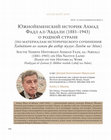
Южнойеменский историк Ахмад Фадл ал-‘Абдали (1881 – 1943) о родной стране (по материалам исторического сочинения Хадиййат аз-заман фи ахбар мулук Лахдж ва ‘Адан), 2021
Ahmad Fadl al-‘Abdali (1881 – 1943) is a remarkable cultural figure of Southern Yemen. A close ... more Ahmad Fadl al-‘Abdali (1881 – 1943) is a remarkable cultural figure of Southern Yemen. A close relative of the sovereigns of Sultanate of Lahdj, he displayed himself as a poet, a musician, a horticulturist, a general, a politician and, last but not least, a historian. While describing his native Lahdj and Aden, ruled by the British, in the historical work of Hadiyyat al-Zaman fi Akhbar muluk Lahdj wa ‘Adan al-‘Abdali revealed himself as a genuine adherent of the traditional Arabic school of history-writing, who nevertheless acquired some “alien” lessons and innovations. While telling the story of Ahmad Fadl al-‘Ablali and his work on history, the Author of the article puts his study into a broad historical framework, besides sharing the reader his own impressions on the visit to Southern Yemen undertaken in 1982.
Key words: Southern Yemen, Lahdj, Aden, Ahmad Fadl al-‘Abdali, Yemeni culture, Yemeni poetry, Arabic history writing
Published: Vostochniy Kuryer. Moscow, 2021, N 3 – 4.
The perl of Oriental Studies, 2021
Prof. Dmitri V. Mikulski is the editor in chief of the academic edition of the late 19 century Ru... more Prof. Dmitri V. Mikulski is the editor in chief of the academic edition of the late 19 century Russian translation of the famous work by August Müller (1848 -- 1892) “Islam in the West and the Orient”, originally composed in German. In his interview with the monthly “Nauka i Religiya” (“Science and Religion”) (Moscow) D.V. Mikulski considers historic and up-to-date implications of the publication of the new academic edition of Müller’s work, that has appeared to be so important for the Arabic Studies in Russia.

“The Sketch of the Arabic Literature” by V. F. Guirgass (1835–1887) in the context of the Russian Arabic Studies d the 19th century and the present situation in our branch of scholarship, 2021
Professor of the Oriental Faculty of the Imperial University of St. Petersburg Vladimir V. Guir... more Professor of the Oriental Faculty of the Imperial University of St. Petersburg Vladimir V. Guirgass (1835 – 1887) is one of the founders of the Academic Arabic Studies in Russia and the first Russian Arabist of the European level. As a young man V.V. Guirgass carried out an extremely fruitful Academic journey to the Arab Orient, which was also eminent for him from the vie-point of areal studies. The results of this travelling experience produced a substantial effect upon the rest of the life of Guirgass as a scholar and as a professor. The legacy of Guirgass appears to be to a high degree fundamental. Among his exploits are educational supplies (on the Muslim Law and the Arabic Literature), readers for beginners in Arabic, as well as for advanced students (the latter is aimed at instructing future experts in divers genres of the Classical Arabic Literature) and the first Arabic-Russian Vocabulary, which still remains unique as a dictionary of the Classical Arabic in Russia. At the termination of his earthy life V. Guirgass prepared for the publication the text of a major classical Arabic Medieval work on History, that is Kitab al-Akhbar al-Tiwal (The Book of the Long Narrations) by al-Dinawari (9 c.). Some of the attainments carried out by V. Guirgass are shared by his disciple, who later was promoted to the membership of the Russian Imperial Academy of Sciences, V.R. Rosen (1849 – 1908). The two scholars were active at those times, when the essential Arabic sources, that they were anxious about, still remained unpublished in the form of manuscripts. All these items are under the discussion in the present article. In the course of the presentation, the Author analyses the works by Guirgass that became available to him for a study lake that. Special attention is paid to “The Sketch of the Arabic Literature” (1874), as there is a project of carrying out its new edition. The work is of a special importance, as it has been for a long time the only complete account of the Classical Arabic Literature in the Russian Language, aimed at the purposes of the Higher Education in the field of the Arabic Studies. While informing the present-day Arabists about the life and acts of a for-father of our contemporary Studies, the Author was striving to reveal their continual value for our profession.

Arab-Muslim military ethics as presented in the Arab-Muslim Dynastical Chronicles (on the basis of the Data Base of the themes and narrative motives of the Arab-Muslim Dynastical chronicles of the 9 – 10 centuries) , 2021
A considerable part of materials, that comprise the texts of the Arab-Muslim Dynastical chronicle... more A considerable part of materials, that comprise the texts of the Arab-Muslim Dynastical chronicles of 9 – 10 centuries (works, where the Muslim History is narrated according to the reigns of the caliphs) deals with the war ethics. The works on History under consideration reveal, that the Arab-Muslims, while at war, were proclaiming certain ethic principles and were to a certain extent fulfilling them. They were aware, that war causes misfortunes and while taking part in it one should rely upon Allah’s will and face death without hesitation. As far as the overwhelmed adversary is concerned, one should treat him mercifully. To outrage the dead body of a slain enemy is a mean deed. Furthermore a woman, who finds herself at a military theatre , deserves protection and indulgence. The passages under analysis present not only a rich frame of events, concerning the move of hostilities, but also give mental pabulum for the contemplation over social psychology of the participants of the historical process in the Arab-Muslim world.
Key words: Arab-Muslim Dynastical chronicles, military ethics, war in the Arab-Muslim world, booty in the Arab-Muslim world, aman, woman at war, a valiant Arab knight
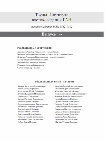
French Translations of the Arabic Erotic Treatise «The Fragrant Garden for Spiritual Delights» by Shaykh al-Nafzawi (14th ct.) ― a story of adaptation of a medieval text in the 19‒20th centuries: in connection with acquisition of a rare edition of the translation (1953), 2021
The author made up his mind to compose the present article after he became the owner of a rare ed... more The author made up his mind to compose the present article after he became the owner of a rare edition: the French translation of the famous North-African erotic treatise “The Perfumed Garden” (14th c.). This book, printed in Paris in 1953, goes back to the 1886 edition, carried out in Paris by the prominent French publisher of erotic literature I. Liseau, and the latter, in turn, to the first lithographic edition of the French translation of “The Garden…” (1876, Algeria) based on the 1850 manuscript translation of the treatise. On the basis of the studies of French Arabists as well as on the grounds of his own observations D. V. Mikulski traces the origin of the interest towards “The Garden…” among the Frenchmen who were serving in Colonial Algeria and depicts the story of the emergence of the French translation of the treatise, which in turn became the foundation of its translation into English and other European languages. The article also examines the second French translation of “The Garden…”, carried out in Algeria in 1860 and published in Paris in 1935. D. V. Mikulski reconstructs the working methods of the first \137\French translators of the treatise and reveals the solid academic basis, against which they were leaning. The article shows that the history of the French translation of the “Perfumed Garden” is a brilliant page of French Arabic studies and the French culture of the second half of the 19th century.

At the 16 th Sharjah academic conference on the Arabic electronic (interactive) novel (Amman September 2019), 2020
Резюме: статья посвящена 16-й Шарджийской литературоведческой конфе-ренции, которая проводилась в... more Резюме: статья посвящена 16-й Шарджийской литературоведческой конфе-ренции, которая проводилась в сентябре 2019 г. в столице Иордании Аммане. Автор рассказывает о том, как была организована это научная встреча, а также излагает научные проблемы, которые были затронуты в связи с рассмотрением ее темы-сущность и особенности арабского электронного (интерактивного) романа. Самое интересное в статье-это пересказ бесед автора с его новыми знакомыми, арабскими писателями и литературоведами, а также с обычными амманцами, с которыми автору довелось встретиться во время этой поездки. Они рассказывали о своем отношении к России, о восприятии многих фактов и явлений арабской классической культуры, о понимании проблем развития и бытования арабского языка, о своих семейных корнях. Статья дает яркое пред-ставление о современной социокультурной обстановке в арабском мире, где сочетаются новейшие явления культуры и традиционные установления, уходя-щие корнями в глубокое прошлое. Ключевые слова: Шарджийские конференции; арабская литература; арабское литературоведение; арабский электронный (интерактивный) роман; арабская классическая словесность; арабская музыкальная культура; семейно-родствен-ные группы; Россия и арабский мир Для цитирования: Микульский Д. В. На 16-й Шарджийской литературоведче-ской конференции: «Арабский интерактивный роман: сущность и особенности» (Амман, сентябрь 2019 г.). Ориенталистика. 2020;3(2):851-880. Abstract: The article tells the story of the Author’s participation in the 16-th Sharjah conference on contemporary Arabic literature, that was held in Amman (Jordan) in September 2019. D.V. Mikulski explains the way it was organized, as well as he exhibits the academic problems, that were touched upon in the context of the theme of the forum – that is the Arabic electronic (interactive) novel, its essence and features. The most interesting element of the article is the retelling of the conversations, that were held by the Author with Arab writers and scholars of literature, as well as with rank-and file Ammanians, with whom the destiny made D.V. Mikulski meet. They expressed D.V. Mikulski their attitude towards Russia. The Arab intellectuals, as well as the other aquaintances could not ignore the classical Arabic literary and cultural legacy, the development of the modern Arabic language and their family roots. The article presents a vivid image of the present-day socio-cultural situation in the Arab world, where most recent cultural phenomena and traditional institutions, dating back to centuries ago, are combined.
Key words: the Sarjah conferences, Arabic literature, Arabic study of literature, Arabic electronic (interactive) novel, Arabic classical literature, Arabic musical culture, Russia and the Arab World
Kashf al-ghumma al-djami‘ li-akhbar al-umma -- a contemporary Omani edition of a history of Oman composed at the end of the 18 century., 2020
The article presents the contemporary edition of the major late 18-century work on the history of... more The article presents the contemporary edition of the major late 18-century work on the history of Oman Kashf al-ghumma al-djami‘ li-akhbar al-umma by al-Izkawi (Masqat, 2012). The author of the article analyses the contents of the work, as well as he highly assesses the academic apparatus of the edition, carried out by local Omanian scholars. The edition is a vivid example of the attention paid in present-day Oman to the national historic and literal heritage.

A unique copy of an antique English treatise on the study of Islam (1723): concerning the development of the Arabic Studies in Western Europe in 17 – 18 c.c., 2018
Д.В. Микульский
Уникальный экземпляр старинного английского исламоведческого трактата (1723... more Д.В. Микульский
Уникальный экземпляр старинного английского исламоведческого трактата (1723): к истории становления арабистики в Западной Европе в XVII – XVIII вв.
В 2012 г. в моем владении оказалась некая книга, изданная в Лондоне в 1723 г. Выяснилось, что это полемическое жизнеописание пророка Мухаммада, написанное одним из известных англиканских церковных деятелей второй половины XVII – первой четверти XVIII в., историком, гебраистом и арабистом, Хамфри Придо (Humphrey Prideaux; 1648 -- 1723). Сочинение Придо неоднократно издавалось при жизни автора и после его кончины. О популярности трактата свидетельствует тот факт, что находящийся в моем распоряжении экземпляр принадлежал, что подтверждает владельческая надпись, американской писательнице и общественному деятелю Кэтрин Вильямс (Catherine Williams; 1787 – 1872).
Ключевые слова:
Пророк Мухаммад, английская арабистика, Х. Придо, К. Вильямс, христиано-исламская полемика
D.V. Mikulski
A unique copy of an antique English treatise on the study of Islam (1723): concerning the development of the Arabic Studies in Western Europe in 17 – 18 c.c.
In 2012 I became an owner of a book, published in London in 1723. It appeared to be a polemical biography of the Prophet Muhammad by one of the well-known Anglican Church personalities of the second half of 16 – the first quarter 17 centuries Humphrey Prideaux (1648 – 1723), who was a historian, an Arabist and a Hebraist. The work of Prideaux was several times published during his lifetime, as well as posthumously. In 1698 the French translation appeared. The popularity of the treatise in question is proved by the fact that as late as 1885 the famous R.F. Burton (1821 -- 1890) was expressing his disagreement with the concept of the character of the activities Prophet Muhammad, worked out by Dr. Prideuax, and still later, in 1896, a French scholar of Islam H. de Castries (1850 -- 1927) was also contradicting the ideas, expressed in Prideaux’s work. In addition to all these facts I am pleased to point out, that the copy nowadays in my possession once upon a time belonged to an American writer and public personality Catherine Williams (1787 – 1872), which is proved by the possessor’s inscription.
Key words:
the Prophet Muhammad, English Arabic Studies, H. Prideaux, C. Williams, Christian-Muslim polemics, the biographical genre
Published: Труды Института востоковедения РАН. Выпуск 14. Письменные памятники Востока. Проблемы перевода и интерпретации. Избранные доклады. Том II. М. Российская академия наук. Институт востоковедения, 2018, с. 161 – 171.
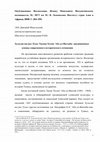
Khulasat ta’rikh Tunis by Hasan Husni ‘Abd al-Wahhab (1884 – 1869): traditional foundations of a modern historical work , 2008
D. Mikulslki
Khulasat ta’rikh Tunis by Hasan Husni ‘Abd al-Wahhab (1884 – 1869):
... more D. Mikulslki
Khulasat ta’rikh Tunis by Hasan Husni ‘Abd al-Wahhab (1884 – 1869):
traditional foundations of a modern historical work
The work under study has for a long time been the main textbook on the history of Tunisia, written in Arabic.
The author of the paper managed to show that the traditional character of the work under study exhibits itself in the following features:
compositional irregularity in the relation of the history of Tunisia as a whole;
dynastical character (according to the reigns of princes) of the composition of historical materials;
traditional range of themes of the materials, that comprise the content of the work;
absence of the academic instruments, characteristic of the modern history-writing.
Similar works on history used to appear rather often in the Arab world in 20 century. There are specimen of such works published in 21 century. Thus the work by H.H. ‘Abd al-Wahhab is rather a typical phenomenon, which signifies the stability of the Arabic written culture.

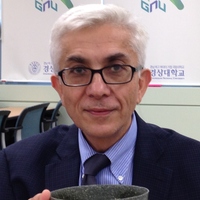



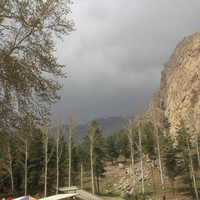





Uploads
Papers by Dmitri Mikulski
(d. 956) was also a remarkable story-teller. This reputation of the Author is rightly
based upon the main of the two remaining his works, that is Murudj al-dhahab wa
ma‘adin al-djawhar (“The Meadows of Gold and the Mines of Gems”). In the section of
this work, where the events of the rule of the Umayyad dynasty (661–750) are related,
al-Mas‘udi creates vivid images of the caliphs, of their adversaries, their courtiers,
as well as of ordinary people, who lived in the epoch of their reign. It is testiied by the
academic translation of a number of novellas (stories) and passages of other genres
manifested in the present publication. These translations are interesting to both experts
in Oriental studies and to a broad reading circle.
Summary
A.A. Dolinina is the contemporary of the Second World War at the territory of the former Soviet Union and of the Siege of the City on the Banks of Neva River. We gained the Victory owing to the firmness of our soldiers as well as thanks to the devout serving, on whom it was bestowed to preserve and to present to the Nation the great Universal and National cultural values.
A testimony of that is the edition of a free translation of “The Song of Roland”, carried out in 1943, soon after the break of the Siege. It is a worthy landmark of that Great Epoch.
Keywords: al-Mas‘udi, Arab-Muslim science of History, Medieval literature and folklore, kiyafa, traditions about the origin of the Arabs, Bedouins in the pre-Islamic epoch, pre-Islamic Arabia inArab-Muslim history writing
For citation: Mikulsky Dimitry V. Al-Mas‘udi on the Important Personalities of the Arabic Olden
Days. The Legendary Tradition about the Nizar’s Sons’ Partition of Fatherly Legacy. Oriental Courier.
2023. No. 1. Pp. 251–263. DOI: 10.18254/S268684310025328-8
Key words: Southern Yemen, Lahdj, Aden, Ahmad Fadl al-‘Abdali, Yemeni culture, Yemeni poetry, Arabic history writing
Published: Vostochniy Kuryer. Moscow, 2021, N 3 – 4.
Key words: Arab-Muslim Dynastical chronicles, military ethics, war in the Arab-Muslim world, booty in the Arab-Muslim world, aman, woman at war, a valiant Arab knight
Key words: the Sarjah conferences, Arabic literature, Arabic study of literature, Arabic electronic (interactive) novel, Arabic classical literature, Arabic musical culture, Russia and the Arab World
Уникальный экземпляр старинного английского исламоведческого трактата (1723): к истории становления арабистики в Западной Европе в XVII – XVIII вв.
В 2012 г. в моем владении оказалась некая книга, изданная в Лондоне в 1723 г. Выяснилось, что это полемическое жизнеописание пророка Мухаммада, написанное одним из известных англиканских церковных деятелей второй половины XVII – первой четверти XVIII в., историком, гебраистом и арабистом, Хамфри Придо (Humphrey Prideaux; 1648 -- 1723). Сочинение Придо неоднократно издавалось при жизни автора и после его кончины. О популярности трактата свидетельствует тот факт, что находящийся в моем распоряжении экземпляр принадлежал, что подтверждает владельческая надпись, американской писательнице и общественному деятелю Кэтрин Вильямс (Catherine Williams; 1787 – 1872).
Ключевые слова:
Пророк Мухаммад, английская арабистика, Х. Придо, К. Вильямс, христиано-исламская полемика
D.V. Mikulski
A unique copy of an antique English treatise on the study of Islam (1723): concerning the development of the Arabic Studies in Western Europe in 17 – 18 c.c.
In 2012 I became an owner of a book, published in London in 1723. It appeared to be a polemical biography of the Prophet Muhammad by one of the well-known Anglican Church personalities of the second half of 16 – the first quarter 17 centuries Humphrey Prideaux (1648 – 1723), who was a historian, an Arabist and a Hebraist. The work of Prideaux was several times published during his lifetime, as well as posthumously. In 1698 the French translation appeared. The popularity of the treatise in question is proved by the fact that as late as 1885 the famous R.F. Burton (1821 -- 1890) was expressing his disagreement with the concept of the character of the activities Prophet Muhammad, worked out by Dr. Prideuax, and still later, in 1896, a French scholar of Islam H. de Castries (1850 -- 1927) was also contradicting the ideas, expressed in Prideaux’s work. In addition to all these facts I am pleased to point out, that the copy nowadays in my possession once upon a time belonged to an American writer and public personality Catherine Williams (1787 – 1872), which is proved by the possessor’s inscription.
Key words:
the Prophet Muhammad, English Arabic Studies, H. Prideaux, C. Williams, Christian-Muslim polemics, the biographical genre
Published: Труды Института востоковедения РАН. Выпуск 14. Письменные памятники Востока. Проблемы перевода и интерпретации. Избранные доклады. Том II. М. Российская академия наук. Институт востоковедения, 2018, с. 161 – 171.
Khulasat ta’rikh Tunis by Hasan Husni ‘Abd al-Wahhab (1884 – 1869):
traditional foundations of a modern historical work
The work under study has for a long time been the main textbook on the history of Tunisia, written in Arabic.
The author of the paper managed to show that the traditional character of the work under study exhibits itself in the following features:
compositional irregularity in the relation of the history of Tunisia as a whole;
dynastical character (according to the reigns of princes) of the composition of historical materials;
traditional range of themes of the materials, that comprise the content of the work;
absence of the academic instruments, characteristic of the modern history-writing.
Similar works on history used to appear rather often in the Arab world in 20 century. There are specimen of such works published in 21 century. Thus the work by H.H. ‘Abd al-Wahhab is rather a typical phenomenon, which signifies the stability of the Arabic written culture.
(d. 956) was also a remarkable story-teller. This reputation of the Author is rightly
based upon the main of the two remaining his works, that is Murudj al-dhahab wa
ma‘adin al-djawhar (“The Meadows of Gold and the Mines of Gems”). In the section of
this work, where the events of the rule of the Umayyad dynasty (661–750) are related,
al-Mas‘udi creates vivid images of the caliphs, of their adversaries, their courtiers,
as well as of ordinary people, who lived in the epoch of their reign. It is testiied by the
academic translation of a number of novellas (stories) and passages of other genres
manifested in the present publication. These translations are interesting to both experts
in Oriental studies and to a broad reading circle.
Summary
A.A. Dolinina is the contemporary of the Second World War at the territory of the former Soviet Union and of the Siege of the City on the Banks of Neva River. We gained the Victory owing to the firmness of our soldiers as well as thanks to the devout serving, on whom it was bestowed to preserve and to present to the Nation the great Universal and National cultural values.
A testimony of that is the edition of a free translation of “The Song of Roland”, carried out in 1943, soon after the break of the Siege. It is a worthy landmark of that Great Epoch.
Keywords: al-Mas‘udi, Arab-Muslim science of History, Medieval literature and folklore, kiyafa, traditions about the origin of the Arabs, Bedouins in the pre-Islamic epoch, pre-Islamic Arabia inArab-Muslim history writing
For citation: Mikulsky Dimitry V. Al-Mas‘udi on the Important Personalities of the Arabic Olden
Days. The Legendary Tradition about the Nizar’s Sons’ Partition of Fatherly Legacy. Oriental Courier.
2023. No. 1. Pp. 251–263. DOI: 10.18254/S268684310025328-8
Key words: Southern Yemen, Lahdj, Aden, Ahmad Fadl al-‘Abdali, Yemeni culture, Yemeni poetry, Arabic history writing
Published: Vostochniy Kuryer. Moscow, 2021, N 3 – 4.
Key words: Arab-Muslim Dynastical chronicles, military ethics, war in the Arab-Muslim world, booty in the Arab-Muslim world, aman, woman at war, a valiant Arab knight
Key words: the Sarjah conferences, Arabic literature, Arabic study of literature, Arabic electronic (interactive) novel, Arabic classical literature, Arabic musical culture, Russia and the Arab World
Уникальный экземпляр старинного английского исламоведческого трактата (1723): к истории становления арабистики в Западной Европе в XVII – XVIII вв.
В 2012 г. в моем владении оказалась некая книга, изданная в Лондоне в 1723 г. Выяснилось, что это полемическое жизнеописание пророка Мухаммада, написанное одним из известных англиканских церковных деятелей второй половины XVII – первой четверти XVIII в., историком, гебраистом и арабистом, Хамфри Придо (Humphrey Prideaux; 1648 -- 1723). Сочинение Придо неоднократно издавалось при жизни автора и после его кончины. О популярности трактата свидетельствует тот факт, что находящийся в моем распоряжении экземпляр принадлежал, что подтверждает владельческая надпись, американской писательнице и общественному деятелю Кэтрин Вильямс (Catherine Williams; 1787 – 1872).
Ключевые слова:
Пророк Мухаммад, английская арабистика, Х. Придо, К. Вильямс, христиано-исламская полемика
D.V. Mikulski
A unique copy of an antique English treatise on the study of Islam (1723): concerning the development of the Arabic Studies in Western Europe in 17 – 18 c.c.
In 2012 I became an owner of a book, published in London in 1723. It appeared to be a polemical biography of the Prophet Muhammad by one of the well-known Anglican Church personalities of the second half of 16 – the first quarter 17 centuries Humphrey Prideaux (1648 – 1723), who was a historian, an Arabist and a Hebraist. The work of Prideaux was several times published during his lifetime, as well as posthumously. In 1698 the French translation appeared. The popularity of the treatise in question is proved by the fact that as late as 1885 the famous R.F. Burton (1821 -- 1890) was expressing his disagreement with the concept of the character of the activities Prophet Muhammad, worked out by Dr. Prideuax, and still later, in 1896, a French scholar of Islam H. de Castries (1850 -- 1927) was also contradicting the ideas, expressed in Prideaux’s work. In addition to all these facts I am pleased to point out, that the copy nowadays in my possession once upon a time belonged to an American writer and public personality Catherine Williams (1787 – 1872), which is proved by the possessor’s inscription.
Key words:
the Prophet Muhammad, English Arabic Studies, H. Prideaux, C. Williams, Christian-Muslim polemics, the biographical genre
Published: Труды Института востоковедения РАН. Выпуск 14. Письменные памятники Востока. Проблемы перевода и интерпретации. Избранные доклады. Том II. М. Российская академия наук. Институт востоковедения, 2018, с. 161 – 171.
Khulasat ta’rikh Tunis by Hasan Husni ‘Abd al-Wahhab (1884 – 1869):
traditional foundations of a modern historical work
The work under study has for a long time been the main textbook on the history of Tunisia, written in Arabic.
The author of the paper managed to show that the traditional character of the work under study exhibits itself in the following features:
compositional irregularity in the relation of the history of Tunisia as a whole;
dynastical character (according to the reigns of princes) of the composition of historical materials;
traditional range of themes of the materials, that comprise the content of the work;
absence of the academic instruments, characteristic of the modern history-writing.
Similar works on history used to appear rather often in the Arab world in 20 century. There are specimen of such works published in 21 century. Thus the work by H.H. ‘Abd al-Wahhab is rather a typical phenomenon, which signifies the stability of the Arabic written culture.
ДИНАСТИЙНЫХ ХРОНИК IX – X ВВ.
АННОТАЦИЯ
Настоящая База данных представляет собой указатель тем и сюжетов арабо-мусульманских династийных хроник IX – X вв., эпохи, когда происходило становление средневековой арабской историографии. Данный указатель ограничивается темами и сюжетами, касающимися истории мусульманской общины, не охватывая материалов, относящихся к истории домусульманской. Подобная База данных создана в отечественной, да и в мировой арабистике впервые.
Арабо-мусульманские династийные хроники -- это сочинения, в которых история мусульманской общины представлена в соответствии с периодами правления государей – первоначально пророка Мухаммада, а затем халифов.
Понятие «арабо-мусульманские династийные хроники» обнимает не только труды, составленные мусульманами, но также и историками-христианами, жившими в странах Халифата и писавшими по-арабски.
В предлагаемой вниманию пользователей Базе данных фиксируются темы и сюжеты, почерпнутые из следующих основных хроник данного жанра, составленных в IX – X вв.:
Издание хроники Арабское название и символ, которым обозначается хроника
[Ибн Кутайба]. Китаб ал-ма‘ариф ли-Ибн Кутайба Аби Мухаммад ‘Абдаллах ибн Муслим (213 х.(828 м. – 282 х. (889 м.). Хаккаках ва каддам лах Сарват ‘Уккаша. Каир. Матба‘ат Дар ал-кутуб, 1960.
Китаб ал-ма ‘ариф ; КМ
Abu Hanîfa ad-Dînaweri. Kitâb al-ahbâr at-tiwâl. Publié par V. Guirgass. Leide. E.J. Brill, 1888 Китаб ал-ахбар ат-тивал; КАТ
A.b.a. Ya’qub b. Ga’far b. Wahb b. Wadih al Katib al Ya’qubi al-‘Abbasi. Tarih. Tome II. Beirut – Lebanon. Dar Sader publishers. P.O.B. 10, б.г. Та’рих ал-Йа‘куби; Т
The Book of Creation and History . By Motahhar b. Tahir al-Maqdisi, sometimes regarded as the work of ABU ZAID AHMAD B. SAHL al-BALKHI. Edited by PROF. CL. HUART. Offset reproduction from the Publications de l’Ếcole des langues orientales vivantes, Рaris, 1899. Vol. 4 – 6. Teheran. M. H. Asadi’s Publications Series, no. 3 Китаб ал-бад’ ва-т-та’рих; КБТ
Kitab al-‘Unvan. Histoire universelle. Ếcrite par Agapius (Mahboub) de Menbidj. Ếditẻe et traduite par Alexandre Vasiliev, Professeur ả l’Université de Dorpat (Юрьевъ). Second partie (II) // Patrologia Orientalis. Tome VII. – Fascicule 4. Firmin-Didot et Co Primeurs-Éditeurs. Libraire de Paris 56, Rue Jacob. [1912] Китаб ал-‘унван; КУ
Eutychii Patriarchae Alexandrini Annales. Pars posterior … Conjucta opera ediderunt L. Cheicko s.j., B. Carra de Vaux, H. Zayyat. Beryti – Parisiis -- Lipsiae. E Typographeo Catholico -- Carolus Poussielgue, Bibliopola; 15, Rue Cassette, 15 – Otto Harrassowitz, MDCCCCIX Китаб ат-та’рих ал-маджму‘
‘ала-т-тахкик ва-т-тасдик; ТМ
Для регистрации каждого сообщения в базе данных отводится отдельная электронная «карточка». Она подразделяется на две части.
В первой из них, представляющей собой совокупность колонок, фиксируются «выходные данные» сообщения: источник (в виде символа), глава (в виде имени/прозвания главы мусульманской общины, которому она посвящена, и порядкового номера главы в памятнике), порядковый номер сообщения в главе, страница источника, где расположено данное сообщение, объем текста сообщения в строках (с точностью до 0,5 строки), жанр данного сообщения и тема сообщения (например, «личные качества и деяния главы мусульманской общины», «хаджж главы мусульманской общины», «присяга главе мусульманской общины», «назначение наследника халифской власти», «деяния доблестных мужей», «репрессии», «чудеса и природные явления»).
Вторая часть предназначена для фиксации собственно содержания сообщения. Поскольку картотека, лежащая в основе настоящей Базы данных, создавалась в 1982 – 1995 гг., а отдельные ее слои подвергались переделке в 2005 и 2009 гг., характер записи содержания сообщения формировался постепенно – от первоначально краткой до впоследствии весьма подробной, близкой к переводу. В силу этого и в Базе данных содержание сообщений отражено по-разному.
База данных обнимает так называемые сжатые сообщения, беллетризованные сообщения, речения, послания, некрологические сообщения, стихотворные цитаты, коранические цитаты, авторские ремарки, анекдоты и новеллы. Всего в Базе насчитывается около 4000 сообщений.
Автор надеется, что собранный им в течение почти всей его профессиональной деятельности материал не пропадет втуне, но окажется полезным как арабистам и прочим востоковедам, так и всем, кто интересуется историей арабского и, шире, мусульманского мира.
The work was originally published in Russian in 1998 (Moscow. Aleteya). In 2006 the Arabic translation appeared (Damascus, Al-Mada), which was created by the eminent Arabic expert on the Russian language and culture Dr. Adil Ismail and supervised by his colleague Dr. Naawfal Nayyuf .